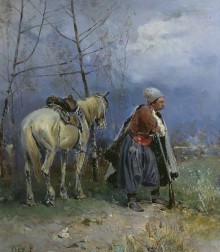The Kharkiv Museum of Art and the Andrei Sheptytsky National Museum in Lviv have exchanged works by two outstanding painters who are the pride of Ukraine’s fine arts and who have done a lot for their respective cities. Lviv has received 128 paintings by Serhii Vasylkivsky, while Kharkiv residents have seen 83 works by Ivan Trush. The Trush exhibition opened on May 24 under the title “The artistic alleys of a Ukrainian neo-romanticist.” The Vasylkivsky exhibition in Lviv is entitled “The Ukrainian life of the Wild Field.”
“These are two completely different schools. Vasylkivsky studied in Saint Petersburg, while Trush was educated in Krakow, Vienna, and Munich. Symbolically, both were not only painters, but also public and cultural activists,” Director of the Kharkiv Museum of Art Valentyna MYZGINA, one of the organizers of the project, says. “Trush initiated exhibitions of works by contemporary painters and was an art and even music critic in Lviv. Vasylkivsky launched a literary and arts group in Kharkiv which recorded the special features of the national architecture, ethnography, and ornamentation and arranged exhibitions of ancient architecture. Many architectural motifs, including those from western Ukraine, are present in his works.”
Unfortunately, a number of his works disappeared during the Second World War. The collection of the Lviv National Museum has only three.
“This has a long-standing practice among world museums. But because such projects require significant organizational and financial investments, they have not been frequent in Ukraine in the past years,” Oksana BILA, deputy director general of the Lviv National Museum and curator of the Trush exhibition in Kharkiv, has told The Day. Myzgina concurs: “Organization of such inter-museum exhibitions is a complicated and costly thing. Transportation is complicated. Our exhibition was carried by special transport – vans with special springs that maintained the necessary temperature and humidity.” Myzgina says that the art exchange project has received funding from private sources. This is the first such exchange project between the two museums, even though the idea was voiced in both Lviv and Kharkiv museums back in the early 2000s.
Both exhibitions will be open until the end of August. A joint album-catalogue of Trush and Vasylkivsky has been published prior to the opening and has been a great success with visitors.
Meanwhile, the administrators of both museums are thinking of further exchanges. In the future, Lviv may see the Kharkiv Landscape Painting School represented by Petro Levchenko, Mykhailo Berkos, and Mykhailo Tkachenko, as well as works by Porfyrii Martynovych.
COMMENTARY
Roman YATSIV, Ph.D. in Art Criticism, vice rector of Lviv National Art Academy:
“This is an extremely significant event for Lviv and, I believe, for Kharkiv, too. It may be the first time that this approach has been used to encourage interest in various powerful artistic events in the history of Ukrainian culture. Given certain geographical distance, we often fail to set up a normal model of viewing the national and cultural unity in various phenomena. Now we, specialists and artists, must take special care to bring forth not some distinctions and local features (which, of course, were there) but the common attributes that defined what we call Ukrainian modernism. The part Vasylkivsky played in this process was very significant. He provided the momentum for forming a national school of landscape painting. He was able to adopt from Taras Shevchenko an existential approach to treating landscapes and a philosophical-historical interpretation of our land and did so in a remarkably sensitive fashion. Vasylkivsky had a deep sense of these issues even within the limits of landscapes. This is a high-profile event for Lviv, because we do lack these examples in a wider format. We have a very fragmented and distanced view of them. Trush, I believe, will have a great historical impact on Kharkiv residents, because he was the one who launched the impressionistic program which sent deep roots in Galicia. At the same time, he was very much oriented to maintain relations with Greater Ukraine. He is fundamentally a figure that equally balances an understanding of the essence of the Ukrainian tradition in landscape painting and, moreover, in some wider dimension.”







